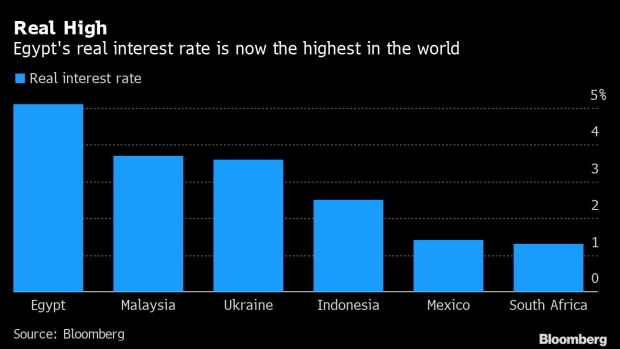Aug 13, 2020
World’s Highest Real Rate Is Right Where Egypt Wants It for Now
, Bloomberg News

(Bloomberg) -- A single emergency interest-rate cut by Egypt at the height of the coronavirus pandemic delivered all the monetary stimulus the economy is likely to get any time soon.
The central bank is treading carefully even after a slowdown in inflation to an eight-month low made Egypt’s key rate the highest among more than 50 major economies tracked by Bloomberg when adjusted for prices. The volatility of capital flows during the health crisis may mean a longer wait before easing restarts.
All but one of the 11 economists surveyed by Bloomberg predict the Monetary Policy Committee will keep its benchmark deposit rate at 9.25% on Thursday. It trimmed borrowing costs a combined 450 basis points last year and another 300 basis points in March.
“While the persistent disinflationary trend observed over the first half of the year opens up room for another cut by end-2020, we expect Egypt’s central bank to remain in wait-and-see mode,” Farouk Soussa, an economist in London at Goldman Sachs Group Inc., said in a report to clients.
Read More: Egypt’s Carry Trade Bounces Back as Foreigners Buy Up Debt Again
As the economic fallout of the pandemic cut into Egypt’s main sources of hard currency -- tourism, remittances and Suez Canal receipts -- the country also saw its biggest-ever capital outflows between March and May amid a global selloff. Foreign investors began to come back in June after Egypt secured financing from the International Monetary Fund.
Foreign holdings of local Treasury bills and bonds climbed to around $14 billion by the end of July from $10.6 billion a month earlier. Egypt’s foreign-currency and local debt has outperformed most other emerging-market peers this year.
The central bank is also finding other ways to pump more money into the economy. In December, it introduced a 100-billion pound ($6.3 billion) initiative to enable industrial companies to borrow at a below-market rate of 8%. The program has grown to include other sectors and firms in the months after the coronavirus flared.
But for the easing cycle to resume, policy makers may wait until Egypt’s key sources of foreign currency “show a promising recovery,” according to Mohamed Abu Basha, head of macroeconomic research at Cairo-based EFG Hermes.
“Despite having ample room to cut interest rates -- considering a widening margin of real yields -- the central bank is satisfied with the level of easing it has so far pushed through,” he said.
©2020 Bloomberg L.P.


